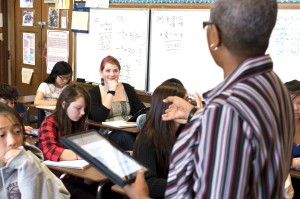Their inventiveness became clear as I helped put together, and then moderated, the opening general session of this year’s Content in Context Conference, organized by the Association of Educational Publishers. Session organizers asked educators far and wide to go into more depth about what’s happening with digital in the classroom, used teachers’ own videos to illustrate, and added a panel to provide the administrator and policy perspective.
The only consistency in deep implementations of tech is that there’s none. Here were some of the loosely common threads and trends:
One-to-one computing. One-to-one initiatives tend to get all of the attention, as though they were the gold standard of ed tech. But one-to-one…what? When the term was coined, it was one student to one desktop computer. Yet only the former has remained constant.
- Fairfax County Public Schools in Virginia is piloting netbooks loaded with online textbooks for social studies classes in middle and high schools. Students like the ability to immediately look up and manipulate information. Teachers like how they support different learning styles. But Jim Siegl, technical architect for FCPS and a session panelist, said one surprise has been that high school students have been more resistant to the e-textbooks than their middle school counterparts—perhaps indicating that once study habits are established, they’re hard to change.
- iPads are the one-to-one device of choice in several district pilots in California and Virginia, noted session video contributor Tina Barseghian of KQED’s MindShift education blog. Pros are iPads are compact, multipurpose, and students can watch videos or repeat information until a concept is understood. But, as Barseghian quotes one educator, even the bright-shiny iPads don’t replace the need to think.
- Grandview High School in Jefferson County, Missouri, has been piloting Android tablets to replace textbooks for students and staff, starting with 20 in January and expanding to 400 for the entire school in August. Similar to iPad pilots, the pluses are portability and being able to have everything in one device. But that flexibility brings with it higher expectations—students noted pilot materials didn’t have electronic bookmarks, highlighting, printable pages, resizable fonts, text-to-speech capability, and a host of other features more common in consumer products.
- In Pascack Hills and Pascack Valley High Schools in New Jersey, more “traditional” laptops rule the one-to-one roost. But it could be because the initiative has been under way since fall 2004, covering about 2,000 teachers and students. With seven years of experience, teachers appreciate the paperless exchange with students and how digital communication and assignments make everyone more accountable. Students haven’t yet tired of the multimedia capabilities, or as one student put it in a science presentation, “This is a live feed of my actual worms!”
Choose your own (technology) adventure. Even one-to-one initiatives were a marvel of consistency, though, compared with how individual teachers creatively cobbled together digital resources to support their students—and their budgets.
- Heather Erickson, a seventh- and eighth-grade communications arts teacher in rural Missouri, deals with limited broadband connectivity and shared computers. Yet she’s using Gaggle and Moodle for student/teacher communication; blogs for classroom commenting on assigned work (emphasizing revision, not just the final product); and other free tools like SurveyMonkey, Wordle.net, Photo Story 3, Animoto, and more.
- Ananth Pai’s third-grade classroom in Maplewood, Minnesota, is stocked with learning games on devices ranging from Nintendo DS handhelds to older desktop computers. Not only do online games let students learn alongside students in other countries, but Pai—spending his own money—is finding student performance gains possible even in products developed for adults, such as the change-making mental skills games in Brain Age 2.
- Philip Walter, a special education teacher at Clarke Central High School in Athens, Georgia, has taken an entirely different approach, using an iPhone and a bar code reader app. Students use both in local stores as the means to learn how to comparison shop. This life skills instruction is augmented by MP3 audio books with images to help non-readers learn and tools, such as AudioMemos and Dragon Dictation, to allow non-writers to submit assignments.
So what should education companies learn from these wildly varying, yet deep, implementations of technology in classrooms? For one, modular—and modifiable—educational content remains a strong need, as evidenced by comments from both students and teachers. It probably comes as no surprise that if these educators aren’t getting resources they can chunk and change from traditional publishers, they’ll turn—and are turning—to free content and Open Educational Resources.
Second, bandwidth matters. It’s the elephant in the classroom. Siegl noted “a day doesn’t go past” when bandwidth isn’t an issue in his district. Digital apps have to be more than web-based or delivered but designed to not be bandwidth hogs and allow caching of content at the school level.
Finally, all three panelists—Fairfax County Public Schools’ Siegl; Darlene Morrison, principal of Cromwell Valley Elementary Regional Magnet School of Technology in Towson, Maryland; and Cheryl Scott Williams, executive director of the Learning First Alliance—nodded knowingly when teachers complained that web filtering/blocking software and district approval policies were obstacles to more broad, creative use of digital resources and technology in the classroom. Products have to satisfy not just those who write the checks at the district level but teachers who ultimately use them day to day.
It’s clear that digital resources and technology are on the upswing in schools. Yet the challenges to education companies posed by a Balkanized digital classroom landscape and conflicts over district and teacher control are equally clear—and weren’t lost on the panel. As Williams wryly noted to the assembled executives, “I’m so glad I don’t have your jobs.”


